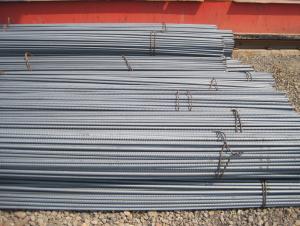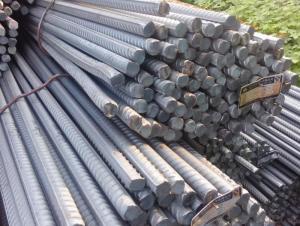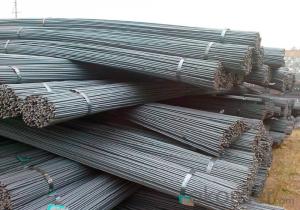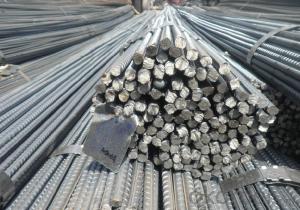ASTM A615 Grade 60 Reinforced Steel Bar
- Loading Port:
- China main port
- Payment Terms:
- TT OR LC
- Min Order Qty:
- 100 m.t.
- Supply Capability:
- 100000 m.t./month
OKorder Service Pledge
OKorder Financial Service
You Might Also Like
Item specifice
ASTM A615 Grade 60 Reinforced Steel Bar
Specifications:
Type | Deformed steel bar/ TMT bars | MOQ | 500 MT (Trial order accepted) |
Standard Grade | GB1499.2-2007, HRB335, HRB400, HRB500. BS4449/2005, B500A, B500B etc.. ASTM A615 Gr.40, Gr60, KS, SD400, SD500 and so on.. | ||
Technique | Hot rolled continuous casting | Length | 6, 9,12m, or as requested |
Size | 6mm-32mm | Payment terms | T/T, L/C at sight, Usance L/C |
Packing | In bundle | Inspection | Third party inspection accepted |
Trade terms | EXW, FOB, CFR, CIF | Trans terms | FIO, FILO, FLT |
Delivery time | 15-30 days, according to the quantity | Note | Customized service is available (for sizes,length and chemical components etc.). |
Steel Grade:
HRB335 | Chemical composition | C | Mn | Si | S | P |
0.17-0.25 | 1.0-1.6 | 0.4-0.8 | 0.045 Max. | 0.045 Max. | ||
Mechanical Property | Yield strength | Tensile strength | Elongation | |||
≥335 Mpa | ≥455 Mpa | 17% | ||||
HRB400 | Chemical composition | C | Mn | Si | S | P |
0.17-0.25 | 1.2-1.6 | 0.2-0.8 | 0.045 Max. | 0.045 Max. | ||
Mechanical Property | Yield strength | Tensile strength | Elongation | |||
≥400 Mpa | ≥540 Mpa | 16% | ||||
HRB500 | Chemical composition | C | Mn | Si | S | P |
0.25 Max. | 1.6 Max. | 0.8 Max. | 0.045 Max. | 0.045 Max. | ||
Mechanical Property | Yield strength | Tensile strength | Elongation | |||
≥500 Mpa | ≥630 Mpa | 15% | ||||
Why choose us:
1. More than 10 years experience in this industry
2. 100,000 tons exporting per month
3. Professional foreign trade tea
4. OEM&ODM capacity
5. High quality assured & competitive price
6. Try our best to meet your needs & save your budget
7. Very popular in Southeast Asia, Africa, Mid-East and South America etc.
8. VIP membership system, first time customers and long-term cooperation customers can get extra discount on some products.
Our Services
1. Offer customers 24/7 service, whenever you need us, we are always here for you.
2. Immediate response. Your any inquiry will be replied within 24 hours.
3. Support small order quantity. For the first time cooperation customers, we can send you less quantity for trial order.
4. Support third party inspection company to inspect and check quality and quantity before delivery.


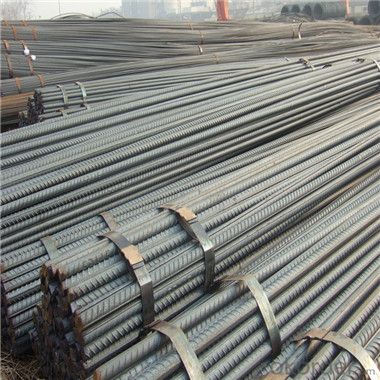

- Q:Are steel rebars suitable for use in extreme weather conditions?
- Yes, steel rebars are suitable for use in extreme weather conditions. Steel has excellent structural strength and durability, making it resistant to harsh environmental factors such as high winds, heavy rainfall, extreme temperatures, and even seismic activity. Additionally, steel rebars can be coated or treated to provide further protection against corrosion in areas with high humidity or exposure to saltwater. Overall, steel rebars are a reliable choice for ensuring the structural integrity of buildings and infrastructure in extreme weather conditions.
- Q:Are there any limitations on the maximum length of steel rebars used in construction?
- Yes, there are limitations on the maximum length of steel rebars used in construction. The length of steel rebars is dependent on various factors such as the structural design, building codes, transportation constraints, and practical limitations. Typically, steel rebars are manufactured in standard lengths and can be extended by overlapping or splicing methods if needed. However, excessively long steel rebars may lead to handling difficulties, transportation issues, and increased risk of bending or damage. Thus, it is essential to adhere to the maximum length limitations specified by the relevant construction regulations and engineering standards.
- Q:How do steel rebars affect the overall thermal stability of a structure?
- Steel rebars can significantly affect the overall thermal stability of a structure due to their thermal conductivity properties. Thermal stability refers to the ability of a structure to withstand changes in temperature without experiencing significant deformation or damage. Steel rebars have high thermal conductivity, which means they can efficiently transfer heat throughout a structure. This property can have both positive and negative effects on the thermal stability of the structure. On the positive side, steel rebars can help in dissipating heat from the structure, preventing the concentration of heat in specific areas. This can prevent localized thermal expansion, which can lead to cracks and structural failures. By evenly distributing heat, steel rebars can improve the overall thermal stability of the structure. On the negative side, steel rebars can also conduct heat to colder areas of the structure, leading to thermal gradients. This can result in differential expansion and contraction, causing stress and potential damage to the structure. Additionally, during fire incidents, steel rebars can rapidly heat up and transfer the heat to the surrounding concrete, reducing its strength and compromising the overall stability of the structure. To mitigate these potential negative effects, engineers and architects must carefully consider the design, placement, and spacing of steel rebars within the structure. By ensuring proper reinforcement layout and utilizing insulation materials, the thermal stability can be enhanced. Additionally, incorporating fire-resistant coatings or insulation around the rebars can help minimize the effects of heat transfer during fire incidents. In conclusion, steel rebars can significantly impact the overall thermal stability of a structure. While their high thermal conductivity can aid in dissipating heat, it can also lead to thermal gradients and potential damage. By carefully considering the design and incorporating appropriate measures, the negative effects of steel rebars on thermal stability can be minimized, ensuring the long-term durability and safety of the structure.
- Q:How are steel rebars classified based on their grades?
- Steel rebars are classified based on their grades according to their minimum yield strength, which is measured in pounds per square inch (psi). The grades range from Grade 40 to Grade 100, with each grade indicating a specific minimum yield strength.
- Q:What is the difference between steel rebars and steel mesh?
- Steel rebars and steel mesh are both widely used in construction as reinforcement materials, but they differ in their shape and application. Rebars are long, cylindrical bars that are typically used to reinforce concrete structures, such as beams, columns, and slabs. They are placed in a grid-like pattern and provide tensile strength to the concrete, preventing it from cracking under pressure. On the other hand, steel mesh consists of interconnected wires that form a grid or sheet-like pattern. It is commonly used in applications such as concrete pavements, sidewalks, and walls. Steel mesh provides both tensile and shear strength to the concrete, distributing the load more evenly and reducing the risk of cracking. In summary, rebars are used for localized reinforcement in specific areas, while mesh provides overall reinforcement across larger surfaces.
- Q:Are there any alternatives to steel rebars for reinforcement?
- Yes, there are several alternatives to steel rebars for reinforcement. Some common alternatives include fiber-reinforced polymer (FRP) rebars, basalt rebars, and carbon fiber reinforced polymer (CFRP) rebars. These alternatives offer advantages such as corrosion resistance, high tensile strength, and lightweight properties. They are often used in applications where steel rebars may not be feasible or suitable, such as in marine environments or structures requiring reduced weight.
- Q:Are steel rebars suitable for reinforcement in theme parks and amusement centers?
- Yes, steel rebars are suitable for reinforcement in theme parks and amusement centers. Steel rebars are commonly used in construction due to their high strength and durability. They provide excellent reinforcement to concrete structures, ensuring the safety and stability of the infrastructure in theme parks and amusement centers, where heavy loads and frequent foot traffic are expected.
- Q:Are steel rebars eco-friendly?
- Steel rebars are not considered to be inherently eco-friendly due to their production process and the extraction of raw materials required. The production of steel involves the extraction of iron ore, which requires significant energy and resources. Additionally, the process emits large amounts of carbon dioxide, contributing to greenhouse gas emissions and climate change. However, it is worth noting that steel rebars have a long lifespan and can be recycled, which helps reduce the environmental impact. Recycling steel requires significantly less energy and resources compared to producing it from scratch, and it helps conserve natural resources and decrease waste. Furthermore, steel rebars are commonly used in construction projects due to their strength and durability. Their use can lead to the construction of long-lasting structures that require fewer repairs and replacements over time. This durability aspect can contribute to a reduction in overall environmental impact. To summarize, while steel rebars are not eco-friendly in terms of their production process, their longevity and recyclability can help reduce their environmental impact when compared to alternative construction materials.
- Q:Can steel rebars be painted or coated for aesthetic purposes?
- Yes, steel rebars can be painted or coated for aesthetic purposes. Painting or coating steel rebars can help improve their appearance and blend them with the surrounding structures or environment. The paint or coating can be chosen to match the desired color or style, allowing the rebars to be seamlessly integrated into the overall design. Additionally, painting or coating the rebars can also provide a layer of protection against corrosion and extend their lifespan. However, it is important to note that the paint or coating used should be specifically designed for steel and capable of adhering well to the surface, ensuring durability and longevity.
1. Manufacturer Overview |
|
|---|---|
| Location | |
| Year Established | |
| Annual Output Value | |
| Main Markets | |
| Company Certifications | |
2. Manufacturer Certificates |
|
|---|---|
| a) Certification Name | |
| Range | |
| Reference | |
| Validity Period | |
3. Manufacturer Capability |
|
|---|---|
| a)Trade Capacity | |
| Nearest Port | |
| Export Percentage | |
| No.of Employees in Trade Department | |
| Language Spoken: | |
| b)Factory Information | |
| Factory Size: | |
| No. of Production Lines | |
| Contract Manufacturing | |
| Product Price Range | |
Send your message to us
ASTM A615 Grade 60 Reinforced Steel Bar
- Loading Port:
- China main port
- Payment Terms:
- TT OR LC
- Min Order Qty:
- 100 m.t.
- Supply Capability:
- 100000 m.t./month
OKorder Service Pledge
OKorder Financial Service
Similar products
New products
Hot products
Related keywords


